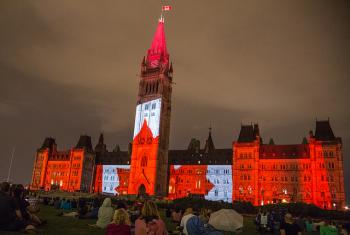Canada acquired its identity as a federal state 150 years ago. A series of constitutional talks in the 1860s brought agreement to create a Canadian Confederation from politicians representing the provinces of Canada, Nova Scotia and New Brunswick; though not immediately from those of Prince Edward Island and Newfoundland.
Though 2017 is unlikely to rival the centenary year of 1967 for celebration, this new year will include local initiatives and public events designed to promote Canada to Canadians; and, yes, allow the Liberal government to shine.
Whatever the public relations designs for marking this 150th year, it should also allow for extended critical reflection on what history has to suggest for Canadian politics today.
The main sources of tension and conflict in Canadian politics were already present in 1867, and can be seen in the questions addressed and the measures adopted in the British North America (BNA) Act.
According to a main proponent, George Étienne Cartier, the purpose of Confederation was to prevent annexation of the remaining British colonies by the American Republic.
The new Canadian parliament was expected to have the financial heft to pay for the armed forces (militia and standing military) needed to defend the Canadian border with the United States.
Not incidentally this would let the British Treasury off the hook, which helps explain why the imperial power assented to confederation.
Trying to satisfy Canadians divided on heated cross-border issues and maintain secure, prosperous, overall relations with the U.S. has been a main preoccupation for Canadian governments since the end of the American civil war, and will remain so following the inauguration of the improbable President Trump. Of great importance in 1867 was the ability of the new Canadian government to borrow money to finance railway construction. Cartier was the lawyer for the Grand Trunk Railway, and instrumental in securing funding for Sir Hugh Allan in the construction of the Canadian Pacific Railway (CPR) -- for which he was personally and amply rewarded. The Macdonald government of which Cartier was a mainstay was eventually defeated after the Pacific scandal erupted around Conservatives accepting money from the CPR.
Efforts by Canadian governments on behalf of big business projects have been a constant practice from the time of railways to the present pipeline era. Unfortunately the public has not been sufficiently informed and alerted to make governments pay the price regularly at the ballot box.
The BNA Act gave Canada a written Constitution (though it was an act of the British Parliament, and would only be Canadianized in 1982).
Unlike in the unitary U.K., the Canadian Constitution divided powers between the central government and the provinces.
Both the provinces and the federal government were governed according to parliamentary democracy along the British model. Figuring out how to make democratically constituted bodies work together within a federation is still a challenge.
Which level of government should do what? And how should its initiatives be paid for? These questions remain central to cabinets and ministers across Canada.
The federal government's spending power has been the main device used by Ottawa for bringing provinces to some agreement.
Unilaterally re-writing financial agreements gets Ottawa in trouble with provincial governments for good reason.
For citizens of a federal state, focusing popular pressure on two levels of government simultaneously is difficult, which helps explains why Canada has no national safety net or anti-poverty strategy, no comprehensive dental or pharmacare, and inadequate child care outside Quebec.
At the Confederation conferences, provincial delegations included both opposition and government party representation, a feature missing in contemporary federal-provincial gatherings, but worthy of emulation.
The 1867 Confederation settlement remedied a serious injustice. In the 1840 Act of Union, Lower Canada lost its legislative assembly (and acquired the debts of Upper Canada) in the ill-fated union imposed on the two British colonies following Lord Durham's Report.
The Act of Union was British retribution for the rebellions of Lower and Upper Canada. A main aim was to extinguish the French language and culture protected along with the Catholic faith by the Quebec Act of 1774, through merger of the Old Province of Quebec (renamed Lower Canada in 1791), with English-speaking Upper Canada.
George Étienne Cartier was the key figure bringing Quebec into Confederation, notwithstanding being active in the 1837 Patriots rebellion.
Despite misgiving about its overriding of provincial authority, Cartier judged the BNA Act provided an opportunity for Quebec to develop as a political society because it could use its Legislative Assembly to forge its own future. In building support, Cartier had the support of the Catholic clergy.
Cartier faced concerted opposition from his fellow Patriots, Les Rouges, which he was able to overcome in 1867, but never to silence thereafter.
Similar nationalist opposition to the limited powers of Quebec within Canada continues to this day, with the Bloc Québécois represented in the House of Commons in Ottawa, and the Parti Québécois in the Quebec National Assembly.
French-language citizens outside Quebec had to wait until 1969 for the Official Languages Act to have Canadian government service in French guaranteed, and until 1982 for the Charter of Rights to open court action at the provincial level to obtain with difficulty French education or health services.
Under the 1867 settlement, education, natural resources, the law of real property and contracts were assigned to the provinces. Meanwhile the federal government was assigned authority over Indigenous peoples without having capacities needed to provide services.
The nation-to-nation negotiating between the British Crown and Canadian Indigenous nations reflected in the 1763 Royal Proclamation was not recognized in the 1867 Constitution.
In the last 150 years, recognition of Aboriginal and Indigenous rights has fared better in the courts than in the political arena. Advances have been disappointing, and tragic living circumstances for Native Peoples all too prevalent.
Replacing the Indian Act and negotiating self-government are major challenges that no Canadian governments have been willing to face.
Now, that would be a project worthy of 150th-year celebration.
Duncan Cameron is former president of rabble.ca and writes a weekly column on politics and current affairs.
Photo: Tony Webster/flickr



Comments
Do
Don't